KENNEDY SPACE CENTER, FL – After a 24 hour delay due to threatening clouds, a SpaceX Falcon 9 rocket soared spectacularly to orbit from the Florida Space coast today, April 14, carrying a Dragon on a science supply run bound for the the International Space Station that will help pave the way for deep space human missions to the Moon, Asteroids and Mars.
Meanwhile, SpaceX’s bold attempt to land and recover the 14 story tall first stage of the Falcon 9 rocket successfully reached a tiny ocean floating barge in the Atlantic Ocean, but tilted over somewhat over in the final moments of the approach, and tipped over after landing and broke apart. Here’s a Vine video posted on Twitter by Elon Musk:
See the video of the launch, below.
SpaceX will continue with attempt to soft land and recover the rocket on upcoming launches, which was a secondary goal of the company. SpaceX released some imagery and video with a few hours of the landing attempt.
“Looks like Falcon landed fine, but excess lateral velocity caused it to tip over post landing,” tweeted SpaceX CEO Elon Musk.
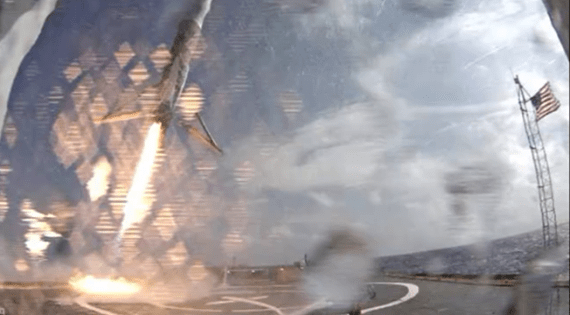
The Falcon 9 first stage was outfitted with four landing legs and grid fins to enable the landing attempt, which is a secondary objective of SpaceX.
The top priority was to safely launch the Falcon 9 and deliver critical supplies to the station with the Dragon cargo vessel.
“Five years ago this week, President Obama toured the same SpaceX launch pad used today to send supplies, research and technology development to the ISS,” said NASA Administrator Charles Bolden.
“Back then, SpaceX hadn’t even made its first orbital flight. Today, it’s making regular flights to the space station and is one of two American companies, along with The Boeing Company, that will return the ability to launch NASA astronauts to the ISS from U.S. soil and land then back in the United States. That’s a lot of progress in the last five years, with even more to come in the next five.”
“Looks like Falcon landed fine, but excess lateral velocity caused it to tip over post landing,” tweeted SpaceX CEO Elon Musk.
A chase plane captured dramatic footage of the landing on the ocean going platform known as the ‘autonomous spaceport drone ship’ (ASDS).
It was pre-positioned some 200 to 250 miles offshore of the Carolina coast in the Atlantic Ocean along the rockets flight path flying along the US Northeast coast to match that of the ISS.
The ASDS measures only 300 by 100 feet, with wings that extend its width to 170 feet.
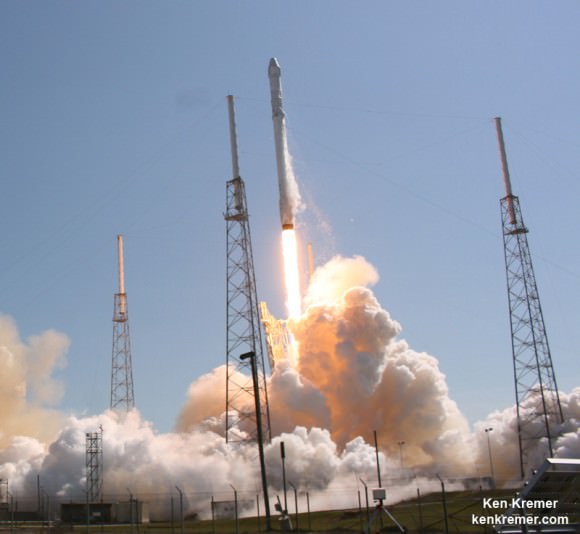
Overall CRS-6 is the sixth SpaceX commercial resupply services mission and the seventh trip by a Dragon spacecraft to the station since 2012.
CRS-6 marks the company’s sixth operational resupply mission to the ISS under a $1.6 Billion contract with NASA to deliver 20,000 kg (44,000 pounds) of cargo to the station during a dozen Dragon cargo spacecraft flights through 2016 under NASA’s original Commercial Resupply Services (CRS) contract.
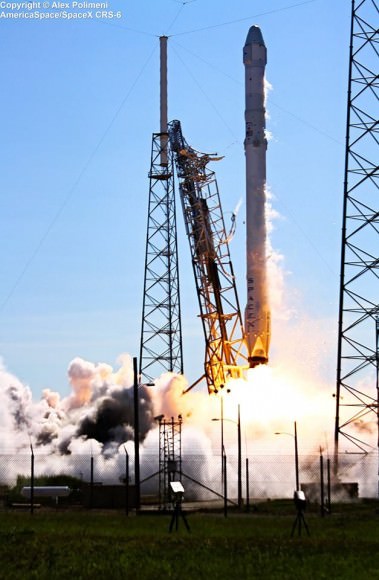
Dragon is packed with more than 4,300 pounds (1915 kilograms) of scientific experiments, technology demonstrations, crew supplies, spare parts, food, water, clothing and assorted research gear for the six person Expedition 43 and 44 crews serving aboard the ISS.
After a three day orbital chase, the Dragon spacecraft with rendezvous with the million post Earth orbiting outpost Friday morning April 17.
After SpaceX engineers on the ground maneuver the Dragon close enough to the station, European Space Agency (ESA) astronaut Samantha Cristoforetti will use the station’s 57.7-foot-long (17-meter-long) robotic arm to reach out and capture Dragon at approximately 7 a.m. EDT on April 17.
Cristoforetti will be assisted by fellow Expedition 43 crew member and NASA astronaut
Terry Virts, as they work inside the stations seven windowed domed cupola to berth Dragon at the Earth-facing port of the Harmony module.
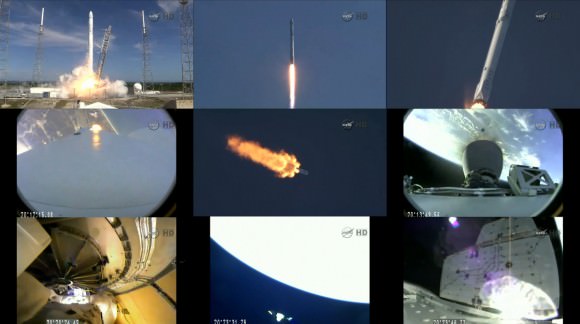
Watch for Ken’s continuing onsite coverage of the CRS-6 launch from the Kennedy Space Center and Cape Canaveral Air Force Station.
Stay tuned here for Ken’s continuing Earth and planetary science and human spaceflight news.
………….
Learn more about SpaceX, Mars rovers, Orion, Antares, MMS, NASA missions and more at Ken’s upcoming outreach events:
Apr 18/19: “Curiosity explores Mars” and “NASA Human Spaceflight programs” – NEAF (NorthEast Astronomy Forum), 9 AM to 5 PM, Suffern, NY, Rockland Community College and Rockland Astronomy Club

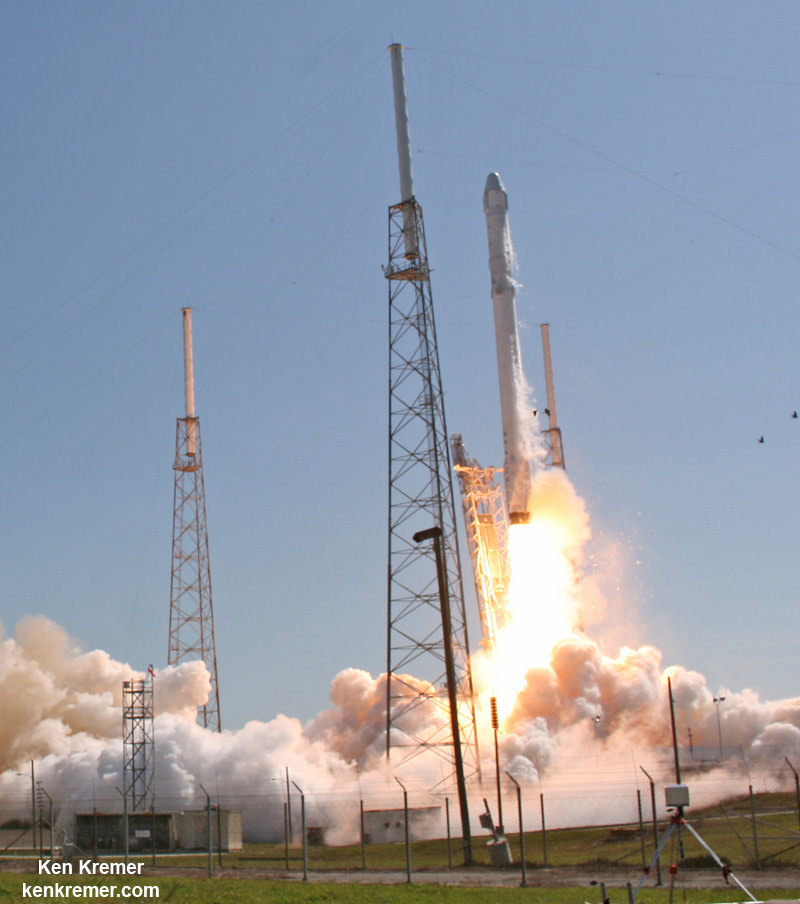
It`s only a matter of time before SpaceX succeeds. There`s just too much to gain and negligible resources to lose. 20 years ago, Commander Pete Conrad (Apollo 12) saw the future and was the proponent of the DC-X Delta Clipper. Today`s successful launch of the Falcon-9 / Dragon is another step in the right direction.
I think it would have been a succesful landing if it was land based.
Flightdeck ships had problems with aircraft landings until they invented the optical landing system, but after that, it was “easy”.
Watched the vine of the landing on twitter and it was very close. Sea winds must be a disadvantage over landfall. I can’t help thinking a small drogue ‘chute or something to add drag at the top of the stage would mitigate the “balancing a broomstick on your finger” effect but then I’m not a rocket scientist.
They instead use fins near the top for that purpose.
To my eyes it seemed not to slow enough after slewing at nearly full engine gimbal way too late. The puff of top-end side thrusters can be seen trying to hold attitude, but perhaps the legs were skidding on the platform by then. If the fuel level at that point were sufficient for a brief hover like a Harrier just before it drops to the deck, it might have worked.
It’s not that it doesn’t have enough fuel, it’s that it has too much engine. If it stops vertical movement before engine off, it will go up again. Even for a single engine regulated down as much as possible, a nearly empty first stage is not heavy enough. I’ve heard it said that SpaceX shoots for something like 2m/s on touchdown, to avoid the possibility of just hopping up again (and presumably getting out of control).
It looks to me as if the computer waited too long to make the final adjustments (and if you think back to the first attempt, it looks as if it was a stronger variant of the same problem, probably exacerbated by the loss of hydraulic fluid and thus the need for stronger corrections). Looks like lateral speed up until the last moment is just too much to hope to be able to correct with the nitrogen boosters on top.
SpaceX said, on the NASA press conference just before the launch, that they had a fuel margin of only 2-3 seconds. I guess that they want to land as near empty as possible (to reduce the damage to the barge :-p). And that the Falcon 9 is not designed to hover. The rockets are to fire precisely enough to stop it exactly when it touches the pad. A bit like how the Soyuz fires its landing rockets.
If they want to do that, then they must stop the pendulum swing long before the last few meters. This clearly did not happen.
One unexpected side wind at the moment of landing can make the difference of fail or success. That happens when you reach surfaces and the long rod sticks way above the surface encountering different wind speeds.
The Soyuz is a ball, not a long rod.
When you look at the start of the clip then you notice that it was already swinging like a pendulum. It never had a chance to land successfully.
It needs to be able to hoover in the last few meters, and the only way they could do that is by adding side thrusters at the top and bottom to stabilize the swinging.
I saw another longer clip more clear of the landing.
Apparently they do have RCS at the top of the rocket to correct the top.
Video is private, aww
You can see that top left thruster desperately trying to keep it upright.
You can see a full video (and see what happens at the end) here . . .
Awww, so close. It looked good, then it looked hopeless, then it almost got straight, then it hung at an angle for what seemed like ages, then over it went.
I wonder whether they could get the barge to move quickly enough to help keep the balance. If the barge had gone to the left just after touchdown, then it might have kept the rocket upright. That is the sort of thing you would do if you were balancing something that shape on your finger.
New clip surfaced from the barge.
https://vid.me/i6o5
Great clip Olaf, So close but no Cigar but well done SpaceX your almost there …..
The explosion as the booster lays down and hits the barge indicates that not all the fuel was used up? I wonder what the barge looks like now? Probably not so good.. and major repairs?
I think it would be easier to land and connect with the barge if the lower part of the booster had a donut or torus shape and the barge contained an identical to slightly larger torus shaped depression like a huge groove. Even if the booster deployed a four part hollow circular torus, that was sort of like a downward facing fender, it could wobble, but not tip over, until it fit and settled into the circular groove in the barge. Since it would be circular the energy and force of the impact would be distributed over a large circular area rather than concentrated on those four spindly supports. Just a thought.
There are all sorts of possible solutions, but we have to avoid adding weight to the rocket, as any extra weight has to go to LEO and back. The present solution has some legs, and some tennis-racquet things at the top end; but no additional weight got the engines and the fuel as a bit of reserve fuel is likely to be there anyhow. They have somehow managed to get that under the weight of a parachute and whatever else is needed to do a soft landing at sea, which is pretty clever of them as parachutes aren’t heavy.
The most efficient solution from the rocket’s point of view might be to have a giant mechanical arm with a soft grip on the barge that can catch and hold the rocket without crushing it.
I think they’re complicating matters needlessly.
Trying to keep the rocket vertical, and at the same time trying to aim for a small target is really not easy.
They should do this on land, on a large flat area. Then the problem of trying to target a very small area would not exist anymore.
Just keep the rocket vertical, and compensate for wind drift, and land anywhere within the large area.